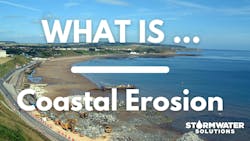Shoreline erosion, coastal erosion and beach erosion occur when various factors, such as sea level rise, strong waves and coastal flooding wear down or carry rocks, soils and sands along the coast, thus changing their shape and strength.
What causes shoreline erosion?
According to the U.S. Climate Resilience Toolkit, all coastlines are impacted by storms and other natural events.
"...the combination of storm surge at high tide with additional effects from strong waves—conditions commonly associated with landfalling tropical storms—creates the most damaging conditions,” the website said.
Geography plays a role in shoreline erosion. In states like California and Florida, powerful waves can impact the shoreline. In Midwest states, like Wisconsin, flooding and uprooted trees alter shorelines.
“A catastrophic natural or human disturbance may cause accelerated erosion. Examples of natural disturbances include large trees uprooted by a windstorm, or a flood resulting from a torrential rainstorm. Human disturbances include vegetation removal, dredging, filling, or construction on or near the shoreline,” the Wisconsin Department of Natural Resources’ (DNR) website said.
Coastal erosion costs the United States approximately $500 million annually in property loss, including damage to both structures and loss of land.
How do humans cause shoreline erosion?
While a lot of erosion is caused by extreme weather and deforestation, humans play a hand in it too. Examples include urbanization, development and pollution. Humans can alter water levels, which impacts erosion as well.
“Pumping of ground water, salt brines, and petroleum resources from coastal environments has led to significant subsidence in many regions,” the U.S. Geological Survey said.
Why is shore erosion bad?
There are many negative impacts of shoreline erosion that span environmental and economic arenas. Shoreline erosion can result in the decrease of a property’s value, and in some cases, some homeowners may have difficulty getting insurance.
The Western Bay of Plenty District Council in New Zealand also finds that erosion can negatively impact drainage systems.
“Coastal and harbour erosion may compromise the performance of surface and stormwater drainage systems in low-lying coastal settlements. Erosion could also damage transport infrastructure (roads and rail) by flooding and/or eroding roads. Changes in sedimentation around the coastline could affect navigation routes. Coastal and harbour walkways/cycleways can also be at risk,” the district’s website said.
And not only does erosion impact property values and infrastructure, it can also impact recreational and commercial activities. If shorelines and beaches are reduced, there is a loss of recreational space, and if water quality is impacted, that directly affects the fishing and aquaculture industries.
How do you fix shoreline erosion?
Shoreline erosion is inevitable, but there are ways to mitigate negative impacts. In a guide made for homeowners, FEMA (Federal Emergency Management Agency) cited both habitat restoration and living shorelines as options for protecting property.
Habitat restoration – “Natural coastal habitats can slow waves, reduce wave height, and reduce erosion. Healthy dunes and wetlands can provide a barrier between the water’s edge and your property, creating a first line of defense,” the FEMA guide said.
Living shorelines – Living shorelines provide stabilization by combining living components with structural ones. Think plants combined with seawalls. Living shorelines can slow waves and mitigate erosion.
The California Division of Boating and Waterways breaks solutions down into two categories – hard and soft. Soft solutions include sand replenishment and dune restoration, while hard solutions include seawalls, jetties or similar combinations.
There are other protection methods. The Wisconsin DNR breaks protection methods into three categories – bank treatments, integrated toe protection and biodegradable/temporary breakwaters. Examples include:
- Brush mattress
- Live staking
- Brush layering
- Fiber rolls
- Biodegradable or temporary breakwaters
About the Author
Katie Johns
Editor-in-Chief
Katie Johns, editor-in-chief of Stormwater Solutions, graduated from the University of Missouri in 2016 with a Bachelor of Journalism and a Bachelor of Arts in Spanish. Johns joined the Stormwater Solutions team in September 2019. Johns also helps plan the annual StormCon conference and co-hosts the Talking Under Water podcast. Prior to entering the B2B industry, she worked as a newspaper reporter and editor in Sarasota, Florida, and a magazine assistant editor in the Chicago suburbs. She can be reached at [email protected].



